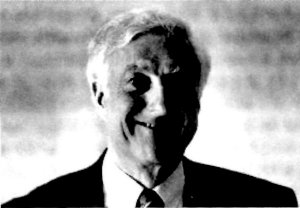Sir Colin Stansfield Smith - TrustNews Sept 13

With the death of Sir Colin Stansfield Smith CBE, the Trust has lost one of its most distinguished members. He trained at the Cambridge University School of Architecture under Professor Sir Leslie Martin, who shared the leadership of the design team responsible for the Royal Festival Hall. Under Sir Leslie Martin, the School was noted for its vigour and unswerving loyalty to the Modern Movement.
The teaching and values of the School lay at the root of Sir Colin's thought for the rest of his life and the aura of Cambridge never lost its fascination for him. A visit to Cambridge with him was something to look forward to with eager anticipation.
Coming as its Architect to the ‘reorganised‘ County of Hampshire in 1974, his responsibilities embraced work in the cities of Southampton and Portsmouth. Both had capable architects departments unburdened by membership of the School Building Consortium which had come into being in the 1950s and 60s. The consortium had been created out of concerns with the economics of scale, reliability of supply and speed of construction but the seeking after architectural excellence was not a primary objective. Hampshire was one of the founders and the largest member of that SCOLA Consortium.
The attainment of architectural excellence drove Colin's ambition. As a result, with his coming, the end of Hampshire's membership of SCOLA became only a matter of time. When it came, the remarkable talents of many of the younger members of its Architects Department could be made full use of for the first time. Architecturally adventurous buildings of much better environmental performance, thoughtfully related to the features of their sites, which were skilfully landscaped and detailed to relate to their surroundings, resulted. The change of culture Colin was now able to bring about began to be noticed and given publicity. County Architects Departments’ work had rarely, if ever been shown in the Royal Academy's Summer Exhibition. From 1976 onwards drawings and models (made by the Department's model-maker) found a place in each Exhibition's Architecture Room year by year.
Awareness of the arts of painting and sculpture and the crafts was vigorously encouraged and the interiors and furnishing in all County buildings carefully considered. Out of collaboration with the Winchester School of Art and the Crafts Council displays of the sculpture of William Pye (1979), Elizabeth Frink (1981) and Henry Moore (1985) of international significance were held in the arena provided by the space in front of the Law Courts, the level below Castle Hill, the steps leading up to the Great Hall and in the Great Hall itself. Because she liked the location chosen for the ‘Horse and Rider statue so much, Elizabeth Frink offered to sell it to the County and City Councils for a fraction of its market value. The offer was declined but action by Colin resulted in the money being raised by an appeal addressed to architects in Hampshire. In the Great Hall itself a suggestion by a leading councillor to commemorate the Royal Wedding in 1981 led to the holding of a competition which resulted in the Charles and Diana stainless steel gates designed and forged by Anthony Robinson being installed in 1983.
Mottisfont Court on the corner of the High Street and Tower Street and the Hampshire County Record Office in Sussex Street stand as major contributions from Colin's own hand to the city scale of Winchester. He was assisted in each case by different, very able architects of the younger generation.
Perhaps Colin's greatest legacy lies in the ambition he imbued and the confidence in themselves he inspired in monitoring, testing and working with younger members of his staff and enthusing his students to understand architecture as an art. The ready willingness of many of the country's most creative and admired private architects and consultants to accept commissions from the County Architect's Department during his time is testimony to the regard and professional respect in which he was held.
